2024 Ford Mustang GT Review: First Drive

Love It | Leave It |
|---|---|
Glorious soundtrack | So thirsty |
Transformed manual experience | Light steering |
Plenty of options to tailor to your tastes | It's how much now? |
The year is 2023. The pony car wars are winding down.
One of the Ford Mustang’s competitors is waving the white flag this year; the other one does it for 2024. So the Blue Oval can just sit back and relax, right? Right?
Uh, yeah, not quite. Meet the 2024 Ford Mustang GT. Like the EcoBoost model we talked about yesterday, the V8-powered pony car has come in for a thorough refresh for its seventh generation. Ford has gifted its icon with more performance, more tech, and a handful of retro features to keep fans engaged. Simply put, if you call yourself an enthusiast, this is the Mustang you want.
What's new?
I won't rehash too much about what Ford has done to create the seventh-generation Mustang here. For a more detailed explanation, I suggest reading the 2024 Mustang EcoBoost review. The condensed version: tweaked platform, similar sizes and weights, and a more chiseled, angular look. Just don't call it New Edge.
The cabin sees a dramatic transformation with a twin-screen setup topping a much simpler dashboard design. Technology is vastly improved, and to a lesser extent, so is quality. Ford has even addressed safety, with new features like a safe exit assist.
From the outside, the GT sets itself apart with an impossible-to-miss hood scoop and big 5.0 badges aft of the front wheels. The standard rolling stock is upgraded to 18 inches and 255-section tires at all corners. Both 19s and 20s are available, the latter coming on slightly wider rubber. There are larger standard brakes as well, measuring 13.9 inches (352 millimeters) up front and 13.8 inches (350 mm) in the back. Like its baby brother, the GT also offers a Performance Package, which, among other things, swaps in staggered, seriously pretty 19-inch alloys with 255/40 and 275/40 Pirellis P Zeroes, hiding even larger brakes with Brembo six-piston calipers up front. There are also thicker anti-roll bars: PP coupes feature 33.3- and 24-mm items, while convertibles use 32- and 21.7-mm thicknesses. The Performance Package adds a crucial Torsen limited-slip differential as well.
Of course, the Coyote remains the heart of the Mustang GT. Displacing the same 307 cubic inches (5,038 cc) as before, the big news here is the addition of dual electronic throttle bodies and a revised crankshaft. Power now extends to 480 horsepower and 415 pound-feet of torque. Option the $1,225 active valve exhaust, and those figures swell to 486 and 418, respectively. That makes this the most powerful GT ever, and the second-most powerful 5.0; the upcoming Dark Horse uses a slightly spicier, 500-horsepower build.
We've known those figures since the calendar flipped over, though. As the drive route takes us up onto the Angeles Crest Highway, however, another important upgrade makes itself known, one that does more to transform the GT driving experience than anything else.
New magic wand
I remember the outgoing Mustang's six-speed manual. It did the job, but it was always a fight: you pushed the clutch, and the clutch pushed back. It made smooth progress difficult.
Yet this is a three-pedal setup transformed. Still the same Getrag MT-82, still the same ratios, but Ford has made huge strides with the clutch pedal. It's friendly, with a fairly long travel but smooth actuation and a clear bite point. The shifter itself is mechanical and just the right amount of notchy, with clear definition between the gates. It's easily better than the somewhat vague setup in the reborn Nissan Z, and might even beat the Camaro. The 27 percent of GT and Dark Horse buyers who are opting for the manual are in for a treat.
The manual is an excellent conductor's wand for that pitch-perfect V8. Rumbly down low and a real singer over 6,000 rpm, the Coyote is a modern classic. It throws down its power generously, but in a way that's wholly predictable and linear. No matter the gear, the Mustang is quick. While it's possible to unravel this route in nothing but third, the reformed shift experience has me rowing through the gears just because.
I didn't love the overly-light steering in the EcoBoost. In normal mode, the GT seems slightly better; maybe it's the extra 240-ish pounds it's packing, so the steering effort better aligns with the slightly slower initial responses. Switch over to the sportier modes, however, and the Mustang's helm gains a good amount of weight, if still short on actual feedback. That said, Performance Package models are still a hoot, the Torsen LSD letting you get on the power nice and early, feeling the neutral chassis subtly rotate right around your hip point. The MagneRide adjustable dampers don't have the range to give the 'Stang Camaro SS 1LE agility, but a) the GT has a much more rounded, everyday ride, and b) that's what Dark Horse will be for, presumably. In the more aggressive modes the GT does well shoving over 3,800 pounds through endless switchbacks. When we get back to civilization, the Mustang smothers bumps and maintains composure over rough tarmac.
Angeles Crest tests cars' brakes, but the GT never sweats it. The enlarged, 15.4-inch (390 mm) front discs have six-piston Brembo calipers clamping down on them, showcasing zero fade and connecting to a progressive, easy-to-modulate pedal.
Ford has a variety of GTs on-hand, so after our sweet red Perf Pack coupe, I try most every other permutation. The 10-speed automatic has revised shift logic, which has it hunting for ratios less than before. Non-PP models have a well-judged suspension tune that finds a happy middle ground between backroad fun and highway cruising.
But oh boy is it thirsty. The EPA quotes just 14 mpg city and 23 mpg highway for the manual, with a combined 17 mpg rating. Canadian figures are 16.6, 10.2, and 13.8 L/100 km, respectively. We were obviously driving spiritedly, so our in-car readings were even worse.
Old-school drive, new-school tech
The cabin refresh has its ups and downs. The dual-screen setup looks wicked sharp, and I love the available customization, especially the Fox Body dials. Sync 4.0 is easy enough to navigate too, with little need to jump into sub- or sub-sub-menus to find what you're looking for. I still take issue with the climate controls being tucked into a menu, however. If you're the type that doesn't stick to one radio station (or music streaming app), the lack of physical controls can prove tedious too. Wireless CarPlay works very well.
Quality is generally good, too. For every hard-touch plastic you encounter lurking under the dashboard, there's a soft red leather seat.
Coupes have the option of aggressive Recaro buckets. Their thin nature liberates a wee bit more back-seat passenger space, but they aren't as comfy for long hauls. Checking that box also means ditching seat ventilation, which I'd argue is very much necessary. The standard seats are the better everyday option, though they lack the level of support needed to counter the Mustang GT's prodigious grip levels.
Performance Pack models gain the electronic "drift brake" parking brake that proved so fun in the EcoBoost at Irwindale the day before. Meanwhile, automatic models now have a remote rev feature, allowing owners to kick off a fusillade of growls and pops even outside the car. No comment there...
2024 Ford Mustang GT: Pricing
If you're so inclined, a bog-standard GT will set you back just $44,090 ($50,595 CAD) including destination. Richer than before, but still a screaming deal for something with this soundtrack and power. Buyers wanting the drop-top have no choice but to move to the GT Premium. The pretty red coupe you see here ends up at roughly $62,475 ($72,390 CAD); the white convertible, $64,225 ($77,090 CAD).
Even though it becomes quite pricey, the duality of the GT is more convincing than the EcoBoost. I can understand someone building a convertible and skipping the Perf Pack and adaptive dampers. They want a stylish cruiser with a killer soundtrack: mission accomplished. Someone else fancies a sportier coupe complete with the hug of those Recaros? Done. The Mustang GT's widespread appeal is why it's going to outlive its competitors (again).
Final Thoughts: 2024 Ford Mustang GT First Drive Review
The 2024 Mustang is a solid evolution of the evergreen pony car. Ford spokesfolk talked about the need to engage the younger generation and their digital inclinations, and the car’s massively improved—and very customizable—tech does just that. The EcoBoost is a great entry-level performer, but as ever, it’s the V8 that gets to the heart of the Mustang’s appeal. Soulful, engaging, and more refined without losing its edge, the GT inches ever closer to sports car territory with the Performance Package, and is an excellent cruiser in drop-top form. No matter which flavor you choose, the message is clear: all hail the pony car king.
Discuss this review on our 7th Gen Ford Mustang forum.
Become an AutoGuide insider. Get the latest from the automotive world first by subscribing to our newsletter here.
2024 Ford Mustang GT | |
|---|---|
Engine: | 5.0L V8 |
Output: | 486 hp, 418 lb-ft |
Transmission: | 6MT/10AT, RWD |
US Fuel Economy (MPG): | 14/23/17 (MT), 15/24/18 (AT) |
CAN Fuel Economy (L/100 km): | 16.6/10.2/13.8 (MT), 15.8/9.8/13.1 (AT) |
Starting Price (USD): | $44,090 (inc. dest.) |
As-Tested Price (USD): | See text |
Starting Price (CAD): | $50,595 (inc. dest.) |
As-Tested Price (CAD): | See text |

Kyle began his automotive obsession before he even started school, courtesy of a remote control Porsche and various LEGO sets. He later studied advertising and graphic design at Humber College, which led him to writing about cars (both real and digital). He is now a proud member of the Automobile Journalists Association of Canada (AJAC), where he was the Journalist of the Year runner-up for 2021.
More by Kyle Patrick



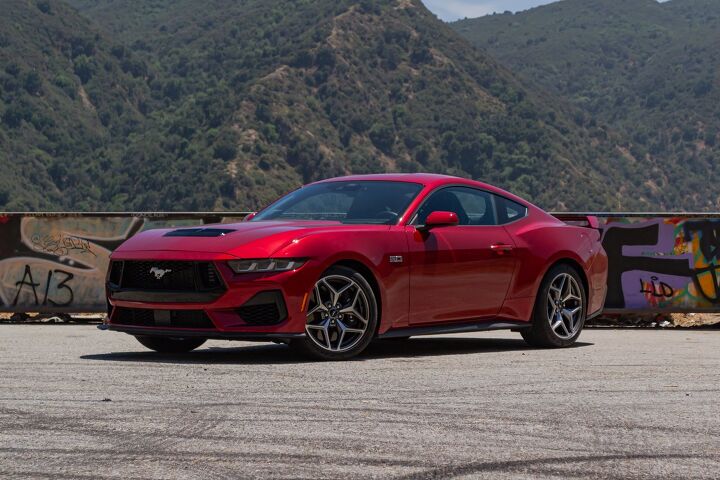
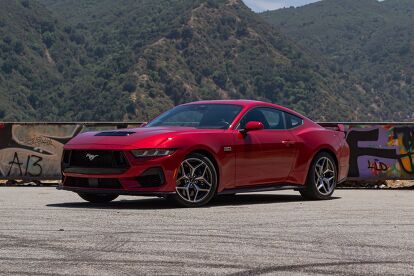





























































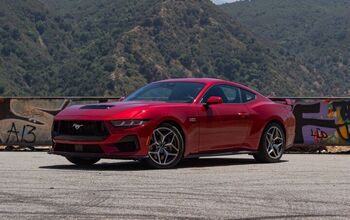


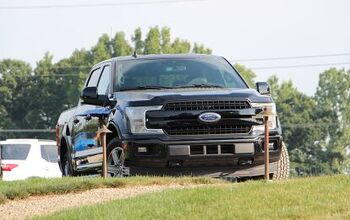

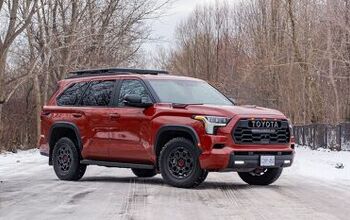


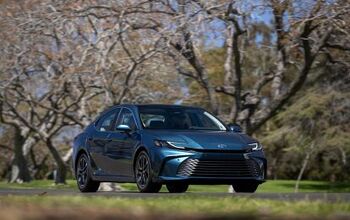





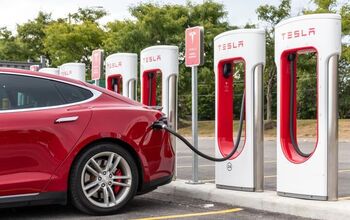
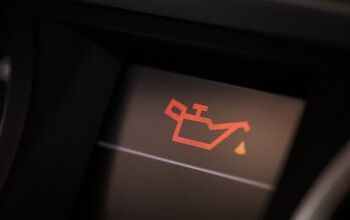
Comments
Join the conversation